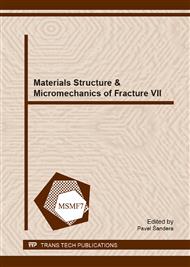[1]
E.A. Dawson, P.A. Barnes and M.J. Chinn: Preparation and characterisation of carbon-coated ceramic foams for organic vapour adsorption, Carbon Vol. 44 (2006), pp.1189-1197.
DOI: 10.1016/j.carbon.2005.10.053
Google Scholar
[2]
G.I. Garrido, F.C. Patcas, G. Upper, M. Tuerk, S. Yılmaz amd B. Kraushaar-Czarnezki: Supercritical Deposition of Pt on SnO2-Coated Al2O3 Foams: Phase Behaviour and Catalytic Performance, App. Cat. A-General Vol. 338 (2008), pp.58-65.
DOI: 10.1016/j.apcata.2007.12.019
Google Scholar
[3]
A.R. Boccaccini, J.J. Blaker, V. Maquet, R.M. Day and R. Jerome: Preparation and characterisation of poly(lactide-co-glycolide) (PLGA) and PLGA/Bioglass® composite tubular foam scaffolds for tissue engineering applications, Mat. Sci. and Eng. C. Vol. 25 (2005).
DOI: 10.1016/j.msec.2004.03.002
Google Scholar
[4]
D.W. Hutmacher: Scaffolds in tissue engineering bone and cartilage, Biomaterials Vol. 21 (2000), pp.2529-2543.
DOI: 10.1016/s0142-9612(00)00121-6
Google Scholar
[5]
I. Dlouhy, L. Rehorek and Z. Chlup: Tensile properties of Open Cell Ceramic Foams, Key Eng. Mat. Vol. 409 (2009), pp.168-175.
DOI: 10.4028/www.scientific.net/kem.409.168
Google Scholar
[6]
E. Prasilova, P. Marcian, D. Krpalek, K. Rehak, R. Malina and V. Konecna: Comparative study of mechanical properties of bone tissue based on the CT and the μCT slices, App. Mech. Mater. Vol. 232 (2012), pp.152-156.
DOI: 10.4028/www.scientific.net/amm.232.152
Google Scholar
[7]
J. Valasek, P. Marcian, D. Krpalek, L. Borak, Z. Florian and O. Konecny: Material Properties of Bone Tissue Obtained from CT for Biomechanics Purposes, Mendel Jou. ser. Vol. 16 (2010), pp.483-490.
Google Scholar
[8]
P. Marcian, O. Konecny, L. Borak, J. Valasek, K. Rehak, D. Krpalek and Z. Florian: On the Level of Computational Models in Biomechanics Depending on Gained Data from Ct/Mri and Micro- Ct, Mendel Jou. ser. Vol. 17 (2011), pp.255-267.
Google Scholar
[9]
P. Marcian, Z. Majer, Z. Florian and I. Dlouhy: Stress strain analysis of high porous ceramics, Adv. Mat. Res. Vol. 482-484 (2012), pp.1330-1333.
DOI: 10.4028/www.scientific.net/amr.482-484.1330
Google Scholar
[10]
P. Marcian, Z. Majer, I. Dlouhy and Z. Florian: Estimation of local mechanical properties of highly porous ceramic materials, Chem. Listy Vol. 106 (2012), pp.476-477.
Google Scholar


